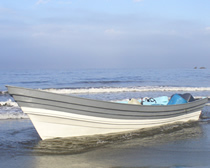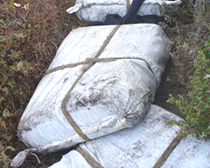13 suspects charged following interdiction of pot-laden 'panga' near San Simeon
LOS ANGELES – Ten Mexican nationals and three U.S. citizens made their initial appearances in federal court Monday on drug charges stemming from their alleged role in an effort to smuggle nearly a ton and a half of marijuana into the United States from Mexico onboard a panga that came ashore near San Simeon Thursday morning.
The incident, which remains under investigation by U.S. Immigration and Customs Enforcement's (ICE) Homeland Security Investigations (HSI), marks the second panga landing in San Luis Obispo County this fiscal year and the northernmost interdiction to date of a maritime smuggling attempt.
"The pilots of these vessels mistakenly believe they can elude detection by taking their contraband farther out to sea and landing farther up the coast," said Claude Arnold, special agent in charge for HSI Los Angeles. "That strategy usually proves futile. Not only is law enforcement on alert for this kind of activity, but the public's vigilance has also enabled us to disrupt an increasing number of these schemes."
The arrests and marijuana seizure came after deputies with the San Luis Obispo County Sheriff's Office responded to information provided by the U.S. Coast Guard about a suspicious vessel making its way toward shore near the Piedras Blancas lighthouse early Thursday morning. When deputies arrived at the scene, they discovered a 30-foot open bow boat on the beach along with 40 bales of marijuana weighing more than 3,000 pounds, including the packaging. The estimated street value of the seized marijuana is more than $3 million.
The 13 suspects are accused in a criminal complaint of possession with intent to distribute more than 1,000 kilograms of marijuana. The violation carries a maximum penalty of life in prison. The defendants are:
- Ruben Estrada-Romero, 41, of Mexico;
- Ezequierl Linares-Fernandez, 26, of Mexico;
- Mario Ibarra-Pena, 48, of Mexico;
- Jesus Elias Moreno-Velasquez, 32, of Mexico;
- Sergio Rosario Espinoza-Zepeda, 30, of Mexico;
- Jose Perfecto Lopez, 25, of Riverside;
- Daniel Mendoza-Torres, 26, of Mexico;
- Blas Hernandez-Ayala, 32, of Mexico;
- Eric Alberto Rocha, 28, of Riverside;
- Julio Valesquez-Rodriguez, 31, of Mexico;
- Casimino Ballardo-Sicairos, 51, of Mexico;
- Ramon Quintero-Avendano, 30, of Mexico; and
- Jorge San Roman-Leon, 37, of El Centro.
In addition to HSI and the San Luis Obispo County Sheriff's Department, the following agencies assisted with last week's interdiction: the California Department of Parks and Recreation; the California Highway Patrol; and the U.S. Coast Guard.
So far this fiscal year (Oct. 1, 2011, through Sept. 6, 2012), there have been more than 190 occurrences of maritime smuggling in Southern California. More than 40 of those incidents involved vessels that came ashore in jurisdictions north of San Diego County. This year's maritime smuggling interdictions have resulted in the seizure of more than 114,000 pounds of narcotics, nearly four times the amount seized in such incidents in all of fiscal year 2011.
Maritime security efforts off the California coastline are being overseen by the Department of Homeland Security's Central California Maritime Agency Coordination Group. The group is comprised of HSI; U.S. Customs and Border Protection; the U.S. Coast Guard; and several state and local law enforcement agencies. The state and local partners include the California Highway Patrol; the California Department of Parks and Recreation; the sheriff's departments of Orange, Los Angeles, Ventura, Santa Barbara and San Luis Obispo counties; and the Los Angeles and Long Beach police departments. The group is also receiving substantial assistance from members of the California National Guard's Counterdrug Program.
For more information, visit www.ice.gov.



